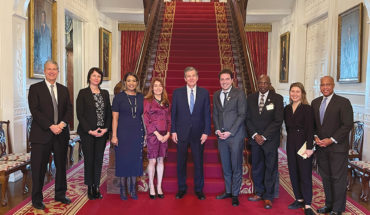photographs by Missy Mclamb
As Raleigh sparkles in the slanting light of a winter afternoon, Red Hat President and CEO Jim Whitehurst, eight stories above it all, looks dazzled. The view of America’s third-fastest-growing city from his company’s new downtown home isn’t bad. But it’s what that vista represents that has him impressed.
“You look around you,” says Whitehurst, 45, his arms spread to indicate the city beyond and Red Hat’s towering headquarters beneath his feet, “and you think, are we really this big?”
The numbers say yes.
Red Hat broke the billion-dollar revenue barrier last year, becoming the first open-source software company to cross that magic line with sales of $1.13B. It was a 25 percent improvement over the year before, helping make Red Hat the 21st-fastest growing tech company in the country, according to Forbes.
Red Hat’s biggest customers include Amazon.com, DreamWorks Animation and the New York Stock Exchange. It operates in 30 countries with 5,000 employees – a number that’s growing 20 to 30 percent a year. And now it’s claiming both the physical home and the mantle of Raleigh’s S&P 500 component from Progress Energy.
So, yes, Red Hat really is that big.
But it’s not hard to see why Whitehurst is still taking it all in. Because his company – like the software it makes, tweaks, and manages – is a groundswell kind of place. Where growth comes organically, through collaboration among colleagues and across divisions, in interactions with customers and the wider world.
“It’s not transactional, it’s an ecosystem.” Whitehurst says, declarative but relaxed in his customary dark jeans, no tie. “Ask any gardener: You don’t know if it was this day that you watered, or that fertilizer, that ultimately made it blossom.” If you empower employees and stoke their ideas, he says, “you’re going to get back more than you gave. It’s never a trade-off. It’s never about transactions.”
Getting back more than it gave is high on Raleigh’s own wish list as the city welcomes its newest downtown tenant. More than $15 million in incentives from the state, tax breaks from the county, and fiscal and parking perks from the city helped lure Red Hat downtown when it began looking beyond its N.C. State Centennial Campus headquarters. Raleigh Mayor Nancy McFarlane called the incentive package “fostering our own,” and she’s not alone in hoping the civic investment in this homegrown success story will prove worthwhile.
“Some people pooh-pooh incentives,” says James H. Johnson Jr., a William Rand Kenan, Jr. Distinguished Professor at UNC’s Kenan-Flagler Business School, who also serves as director of the Urban Investment Strategies Center at the Frank Hawkins Kenan Institute of Private Enterprise. “But you have to look at the long-range return on investment. It will be several-fold what these incentives are.”
Red Hat’s move downtown will not only make up up for local jobs lost when Duke Energy merged with Progress, Johnson says, it will cement Raleigh’s status as a technology cluster. “An influx of 1,000 really, really smart people inhabiting the downtown area will be phenomenal for the city, and for the county, for that matter,” he says. For the city, “this is a really smart strategy. It’s really economic development marketing. People will look at Raleigh as an emerging high-tech, creative class cluster. And success begets success.”
Former Raleigh mayor and Parker Poe partner Charles Meeker also expects Red Hat’s move to be significant. “It brings people who have energy, who will live nearby,” he says, not only eating out, shopping, renting apartments, and buying cars and homes, but also contributing to the life of the community in meaningful ways, like serving on nonprofit boards. “They’ll energize the city.”
Red Hat sells a branded version of Linux, a computer operating system code released 22 years ago by the Finnish-American software engineer Linus Torvalds, who made its code public and invited other developers to use and improve it. By definition, open source software is made and adapted by the community that uses it. By definition, it is free.
Red Hat, however, has figured out how to make serious money from this organic creation, despite widespread skepticism that it was possible at all. In 2001, Microsoft founder Bill Gates said open source software was “a competitor in the student and hobbyist market, but I really don’t think in the commercial market we’ll see it in any significant way.”
Red Hat has turned that prediction on its head by making it possible for Amazon.com, for example, to use its customized open-source software without worrying about bugs or glitches. Red Hat provides its version of open-source, plus technical support, customized products, storage, collaboration, cloud management, and other services for what is essentially a subscription fee.
It’s a fast-growing market that is dominated, so far, by this homegrown company, and led by its unconventional chief. Down-to-earth is how Whitehurst’s employees describe him, and it’s borne out in the details that emerge as he interacts with them, and as he describes his days.
One of the most important things a leader can provide, Whitehurst says, isn’t directives, it’s context: “Here’s what we’re doing, and the role that you play in that. And preferably, the context is something bigger than – hey, we’re in this to make money.” As he approaches an employee in her cubicle for an impromptu chat on a stroll around the new building, she’s clearly comfortable letting him know she’s on the phone; he’ll have to wait.
It’s a customary dose of reality for a leader who doesn’t operate in a traditional hierarchical fashion. He says leadership is earned when “you show some success, and say things that are worth listening to. When people start to listen to you, you become a leader.”
One of the reasons they listen to Whitehurst – besides the three letters that form his title – is because he has passion. “We’re actually changing the way software is delivered and consumed around the world,” he says. “Doing something bigger than just hitting the quarterly numbers. And it’s amazing how powerful that is.”
Red Hatters appear to feel the same way, which is why, at its heart, the consensus culture works, Whitehurst says. “You get people involved upfront, and people have to know that you listen to them.” That brings a pressure of its own. “You have to like debate,” Whitehurst says. “You have to be comfortable with ambiguity, and you have to be comfortable building your own career path.”
The move to Red Hat Tower, as the company has re-christened the former Progress Energy building on East Davie Street, is one the company and its 1,000 local employees (average age: 32) is making thoughtfully, and in stages. Whitehurst says the decision to come here was not his own, though he’d angled for it.
Autocratic decisions from on high are not the open-source style. Instead, an internal team of 40 mapped out where employees lived, canvassed them for opinions, and considered the options. Factors both known and predicted were taken into account. Space was needed for up to 1,700 employees, for instance – a number that assumes annual growth of 20 percent for the next few years. Then, a decision that downtown was the ideal spot “emerged,” Whitehurst says, “and I blessed the decision.”
A Columbus, Ga., native, Whitehurst honed this style of leadership at Delta Air Lines, where he became chief operating officer in 2005, and helped to lead the company out of bankruptcy. He says he learned at Delta that being open with employees, telling them exactly why they’re valued, and treating them as “adults,” not as “cogs,” was the way to make change happen.
The ramifications of group-led decisions can be extensive. Take the renovations to 19 floors of the tower, which took several months, earned LEED gold status for energy efficiency, and allowed “the architecture to reflect the culture” for the first time, Whitehurst says. That doesn’t mean a gigantic red fedora atop the tower, as he suggested early on. “They shot me down on that one.”
What it does mean is “open source design, reflective of an open source culture,” or low, open cubicles pulled back from glass exterior walls; abundant natural light; and small conference rooms everywhere for impromptu group meetings or individual quiet. The two-story open space that used to house Progress Energy’s trading floor will become “community space” with pool tables, Ping Pong, Wii, and tables for dining. The parking deck will include 75 spots for bikes.
And downtown itself will provide a cultural resource that can’t be underestimated, Whitehurst says. “We have a young workforce interested in being in a more urban environment. Being downtown where we can walk, where there are restaurants…it will help us to be closer together.”
It can be difficult to tell which one is the CEO when Whitehurst enters the building with a group of staffers. He carries a backpack; inside is a blue nylon lunchbox that he shares, on occasion, with his son (both of their names are written on it in felt-tip pen).
Whitehurst brings his lunch in part because keeps a close watch on his health. He pulls out a (Red Hat Linux-powered Android) phone to show a photo of the gorgeous pear dessert he broke his rules to eat the previous week, at “a really nice restaurant in Paris.” It was the second or third dessert he’d eaten in a year.
Whenever possible, he brings his family on trips like that: Eleven-year-old twins Emma (“a big time soccer player and chess player” and Jack (“into computers and martial arts”); and his wife, Lauren, whom he met at Harvard Business School, and who works as a visiting professor at Duke.
They’re an active crew, hiking and biking on the American Tobacco Trail near their home in Durham; Whitehurst is a daily runner who ran the Chicago Marathon last October in three hours, 39 minutes.
Unsurprisingly, the Whitehursts also have a thing for technology. At home, he says he has a bit of a problem collecting computers of all kinds. His wife has made a rule: With every new computer that comes in the house, another one has to go.
That’s easier said than done if you operate “two complete parallel universes” as Whitehurst does. His Apple universe includes an iPhone, MacBook Air, and two tablets; his Linux-powered universe is an Android phone, laptop, and two tablets. “That’s a little bit crazy, but I’m interested in the technologies and how they work,” he says.
Nevertheless, Whitehurst believes the “single greatest invention of the 21st century so far” is a Nespresso machine. He has one at work, one at home, and makes himself a simple, straight-up espresso several times a day.
It’s true that for a laid-back leader, Whitehurst does have a caffeinated zeal. Kicked back in his Centennial Campus office on the eve of his own move downtown, he puts his feet up to display cherry red loafers. “It’s impolite to wear hats indoors, so I’ve settled on shoes,” he says. His modest, glorified cubicle is decorated with red hats of every size and type: In addition to the company’s iconic fedoras, there are hard hats, Santa hats, and a Mad Hatter-style top hat.
In his new office, he’ll have room for all of this headgear, plus several chairs and a coffee table, because he thinks there’s “something about a low table” that promotes conversation and collegiality. He will be among the last to move to the tower, and he’s looking forward to his new digs, and to downtown.
When Whitehurst took the CEO job four years ago, it was up to him where to live, Raleigh or Boston. He rented two temporary apartments: One in North Hills, and one in Boston. He applied to schools for his children in both cities; he looked for houses in both cities. For six months, he tried them both out. The kids, then 7, started wearing Tom Brady New England Patriot jerseys, but then Whitehurst steered them south. “It got to be pretty clear. As the leader of the company I thought it would be better to be here, but my wife had a big say in it as well.”
What appealed? “This is a nice place to live, it’s got an incredible number of well-educated people, there’s great arts, incredible college sports. There’s culture, restaurants. It’s green; it’s basically a city in the middle of a park.”
It’s also a place he says he wants the company to “give back” to. “I’m an absolute believer that corporate leadership is civic leadership,” he says, “I’ve always been a proponent of the idea that it’s important to give back to the community.”
N.C. State can vouch for that. As a tenant on Centennial Campus, Red Hat “has been a great community member,” says Terri Lomax, Vice Chancellor for Research at State. In addition to funding “The Garage,” a place for student entrepreneurs to tinker and develop ideas, the company has collaborated on joint research, donated equipment and space, employed student interns, and participated in joint community service projects, like Stop Hunger Now, Lomax says.
Because Red Hat’s customers are global, not local, Whitehurst says, “frankly, we have very few customers here…and therefore our civic activities are truly civic activities. They are not marketing cloaked in civic activity.”
The most visible move so far is Red Hat’s $1.175-million, five-year decision to put its name on the city’s 6,000-seat downtown amphitheater. On a recent afternoon, he took a few minutes to examine the materials that will make the venue unmistakably Red Hat: The red fabric that wraps the perimeter fence, polo shirts for workers, the stage scrim, the signs bearing the fedora logo that will flank the stage. “Are there going to be some bands old enough that I will have heard of them?” he asks the marketing staff.
Community efforts also focus on promoting entrepreneurship. Whitehurst co-chaired the CED Technology Conference here in September, and sits on the board of the N.C. Chamber of Commerce, where entrepreneurship is his focus.
“The concept of networks and clusters is a powerful one,” he says. He speculates aloud about the virtues of an investment fund to spur local tech start-ups. “It’s great that we have some large tech companies here, but so much job growth is coming from small companies. We’ve got to feed that.”
 In the near term, Whitehurst is focused on innovation. Of all the accolades, top rankings, and awards he and the company have received in recent years, Whitehurst says he is proudest of Red Hat’s being called one of the world’s most innovative companies by Forbes in 2012. Forbes said Red Hat is notable because “the idea of transparency and collaboration infuse the entire business.”
In the near term, Whitehurst is focused on innovation. Of all the accolades, top rankings, and awards he and the company have received in recent years, Whitehurst says he is proudest of Red Hat’s being called one of the world’s most innovative companies by Forbes in 2012. Forbes said Red Hat is notable because “the idea of transparency and collaboration infuse the entire business.”
“We beat Google,” Whitehurst says, sounding amazed. “In addition to what we’re doing around software, if we can make the world a slightly more innovative place, and help drive this new concept of this new way to organize that leads to greater collaboration, that’s phenomenal.”







